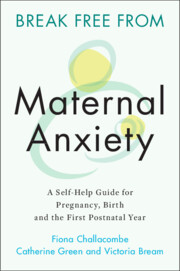 Break Free from Maternal Anxiety
Break Free from Maternal Anxiety Published online by Cambridge University Press: 13 October 2022
Phobias, strong fears related to particular situations, are the most common anxiety problems. People often find a way to live with them in normal life, often by avoiding situations that trigger the fear. Pregnancy and the postnatal period makes this very difficult in the case of two particular phobias, fear of blood, injections and injury (BII) , and fear of vomiting. These situations are impossible to avoid completely at this time and can therefore be very distressing. Fear of vomiting is often related to early memories of this, and keeps going in the present by avoidance and taking particular precautions that keep the anxiety going. This chapter will help you understand and work through these factors to tackle your fears. BII is unique in triggering a fainting response and probably has a large genetic component rather than being learned. We describe proven techniques to apply during exposure exercises to counteract the fainting response triggered in BII, which are known to have a long-lasting effect. Getting on top of these fears will help you manage and enjoy pregnancy and the postnatal year.
To save this book to your Kindle, first ensure [email protected] is added to your Approved Personal Document E-mail List under your Personal Document Settings on the Manage Your Content and Devices page of your Amazon account. Then enter the ‘name’ part of your Kindle email address below. Find out more about saving to your Kindle.
Note you can select to save to either the @free.kindle.com or @kindle.com variations. ‘@free.kindle.com’ emails are free but can only be saved to your device when it is connected to wi-fi. ‘@kindle.com’ emails can be delivered even when you are not connected to wi-fi, but note that service fees apply.
Find out more about the Kindle Personal Document Service.
To save content items to your account, please confirm that you agree to abide by our usage policies. If this is the first time you use this feature, you will be asked to authorise Cambridge Core to connect with your account. Find out more about saving content to Dropbox.
To save content items to your account, please confirm that you agree to abide by our usage policies. If this is the first time you use this feature, you will be asked to authorise Cambridge Core to connect with your account. Find out more about saving content to Google Drive.